
9 minute read
SHERRY LEEDY CONTEMPORARY ART
ANNE AUSTIN PEARCE: "PATH"
June 4 - August 22, 2020
2004 Baltimore Ave. Kansas City, MO 64108 | 816.221.2626 | sherryleedy.com
Catalog design Allison King
Photo credit E.G. Schempf
Artist Statement
Path is a series of paintings conceptually and physically grounded in the act of cutting apart and the evolution that process produces.
As human beings we live in/on earth, in habitats, in homes, within communities and workplaces. We find comfort and, over time, grow into various states of togetherness or oneness passing days, months, and years with each other. The act of cutting apart, and the eventuality of change potentially encapsulate a full spectrum of human emotion. The resulting effect propels one down any number of unknown paths.
When my feet pad across the earth and stones, I imagine all those living things – plant and animal alike – that once lived and are now buried beneath my feet. I can feel the telltale hearts of woolly mammoths, smell the green, fresh ferns and hear the yet-to-be discovered hearts, of the long dead, beat again in me. I have been fortunate to travel on planet earth and have spent as much time admiring, observing, smelling, feeling and caring for her as was possible. It seems that nature never fails to satisfy any large appetite that wants to consume its natural, visual delights and that human appetites never diminish in their desire to own and possess it.
After my many travels, I now find myself relocated for the first time in twenty-five years, having left my home in Kansas and landing in California. Travel now seems both excessive and destructive to all living beings.
There are nine works included in the series titled Path, which began as one large work and eventually became nine interrelated works. Conceptually conceived in Kansas, physically begun in Wyoming and finally completed in California, these 42”x42” paintings are ink, acrylic and collage on paper.
The collaged elements in these paintings are actually drawings that were made in multiple locations around the world. Each collage is tethered by place with a specific visual language tying it to that location. As a human is transformed by each new experience, so are the small paintings made at unique geographical locations. They are now intermingled and representative of specific moments in time and space, interwoven and contextualized, now belonging to these new works.
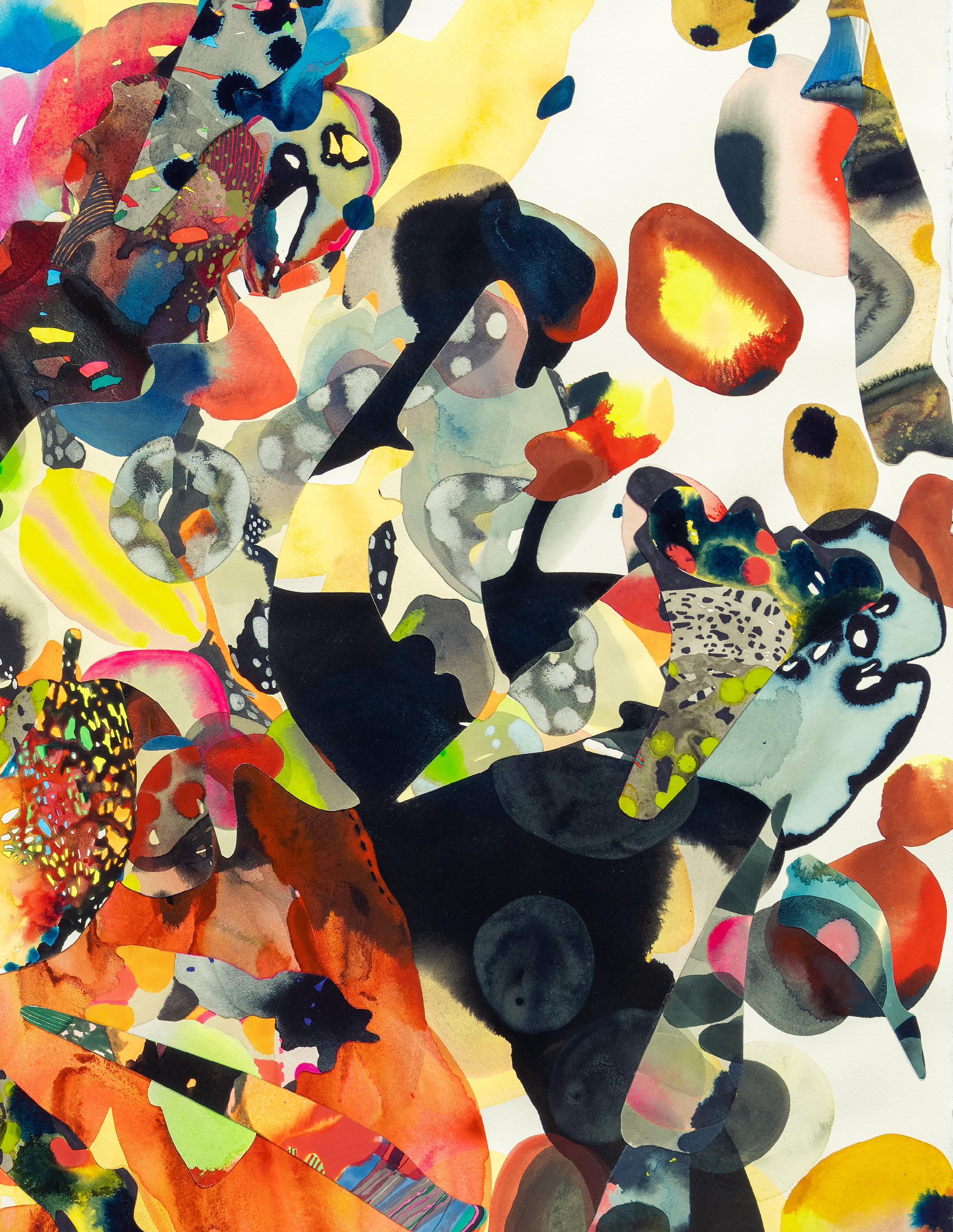
A N N E A U S T I N P E A R C E
"P A T H"
By Elisabeth Kirsch
If you want to find the secrets of the universe, think in terms of energy, frequency and vibration. - Nicola Tesla
Pulsating threads, amoeba- like pods, rainbow pools of color, and surging tentacles swim freely in Anne Austin Pearce’s latest artworks, all in a three-dimensional flux, triggering varying states of consciousness in any who care to see and feel.
“I have an unmediated brain,” Pearce acknowledges; “I’m one hundred percent porous. And I make art every day no matter what. This work is about my geographical and psychic experiences through time.”
Pearce’s abstract, mixed media artworks in Path are hence diaristic, reflecting her long-time fascination with themes of evolution and regeneration. The nine works in this exhibit are cut from one massive roll of paper Pearce painted and drew on the last year and a half as she moved from Wyoming to Kansas City and finally, California. On top of these works, Pearce then cut, spliced and collaged segments from various works of art she had made over the last decade, a “deliberate recycling process” uniting her art and life.
Pearce’s art has always reflected her peregrinations to numerous sites on the planet, but now she has merged her personal time frame with particular insights re the earth’s billion plus years of existence. The branches, veins and layers of strata in her art reference not only the physical steps she has taken over the years, but the psychic, lidar- like connections she makes “to everything that has lived or died.”
There are noteworthy differences between Pearce’s earlier art, known for its sensuous, flowing beauty, and the works in Path, which fearlessly explore the shadow side. Because her layered collages are formed from different color palettes and mixed styles of mark- making, they have the same impact as aerial views of landscape or cross section cuts through the earth, while also denoting the deepest of interior landscapes, both biological and emotional.
Sea Beds Dried and First plunged in Firefly are two of several works that visually reference water, and that are also oceanic in feeling. As with all the works in Path, the sublime and the toxic co-exist, equal parts metaphor for both ecological, and sentient states of being. Whales could sequester in First Plunged in Firefly, and fossilized marine life – or is it toxic oil spills? - might inhabit Sea Beds Dried. Both works could also refer to psychological states that are meditative or despairing.
Does Words Resting in Guts denote swallowed emotions or lethal wastelands? Well Worth Waiting could signify orange poppies in all their glory, noxious fires consuming oilfields, or a state of celebratory well-being. Watson’s Fire and Funeral, with its venomous dark coils, is both seductive and scary; it is ominous, while its patches of glowing indigo hint at the possibility of phoenix rising in the form of clean waters and clear skies.
Cosmic in nature, the works in Path evoke a sense of timelessness at once environmental and spiritual; they also allude to the possibilities of destruction and/or rebirth.
One of Pearce’s favorite books is Micromegas, Voltaire’s seminal 1752 work of science fiction in which two giant aliens from Sirius and Saturn travel the universe together and visit the planet Earth. The humans are indescribably tiny to the giants, but they converse with them anyway, finding them somewhat intelligent and learned. That is, until they learn that humans subscribe to Aquinas’ theory that the universe was made solely for them; at that point the aliens fall over laughing, realizing that Earth’s inhabitants refuse to acknowledge their smallness in the scope of life. Which is one of the points of Path.
Compassion is embodied, nonetheless, in Pearce’s oeuvre. It allows us to understand that past, present and future realities are malleable. We can choose transcendence or remain unconscious; both are both distinct options.
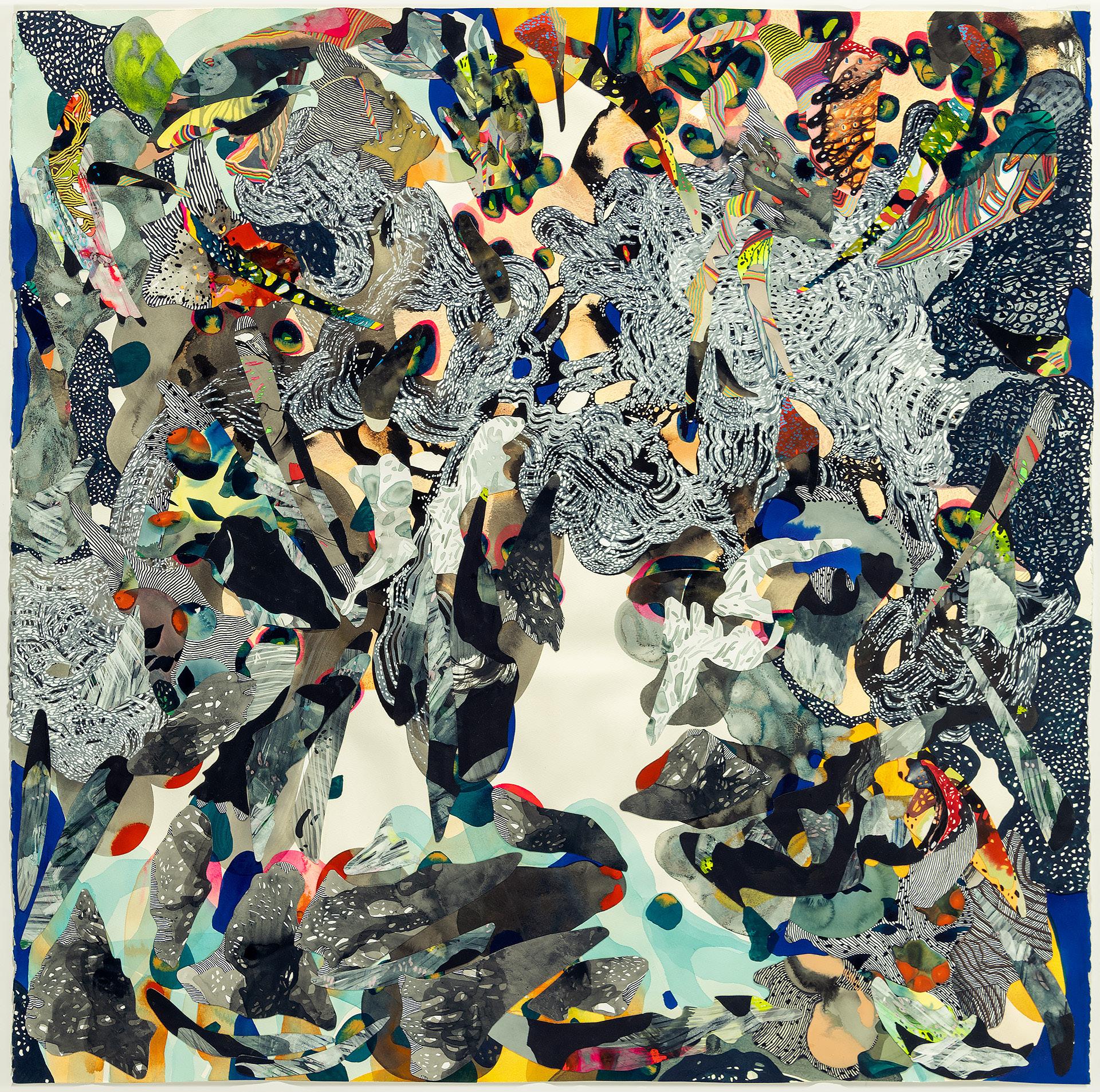
Path: Watson’s Fire and Funeral 2020 Acrylic, inks, collage on paper 44” x 44”

Path: Ancients Under Foot 2020 Acrylic, inks, collage on paper 44” x 44”

Path: Hanged Shafts of Light 2020 Acrylic, inks, collage on paper 44” x 44”
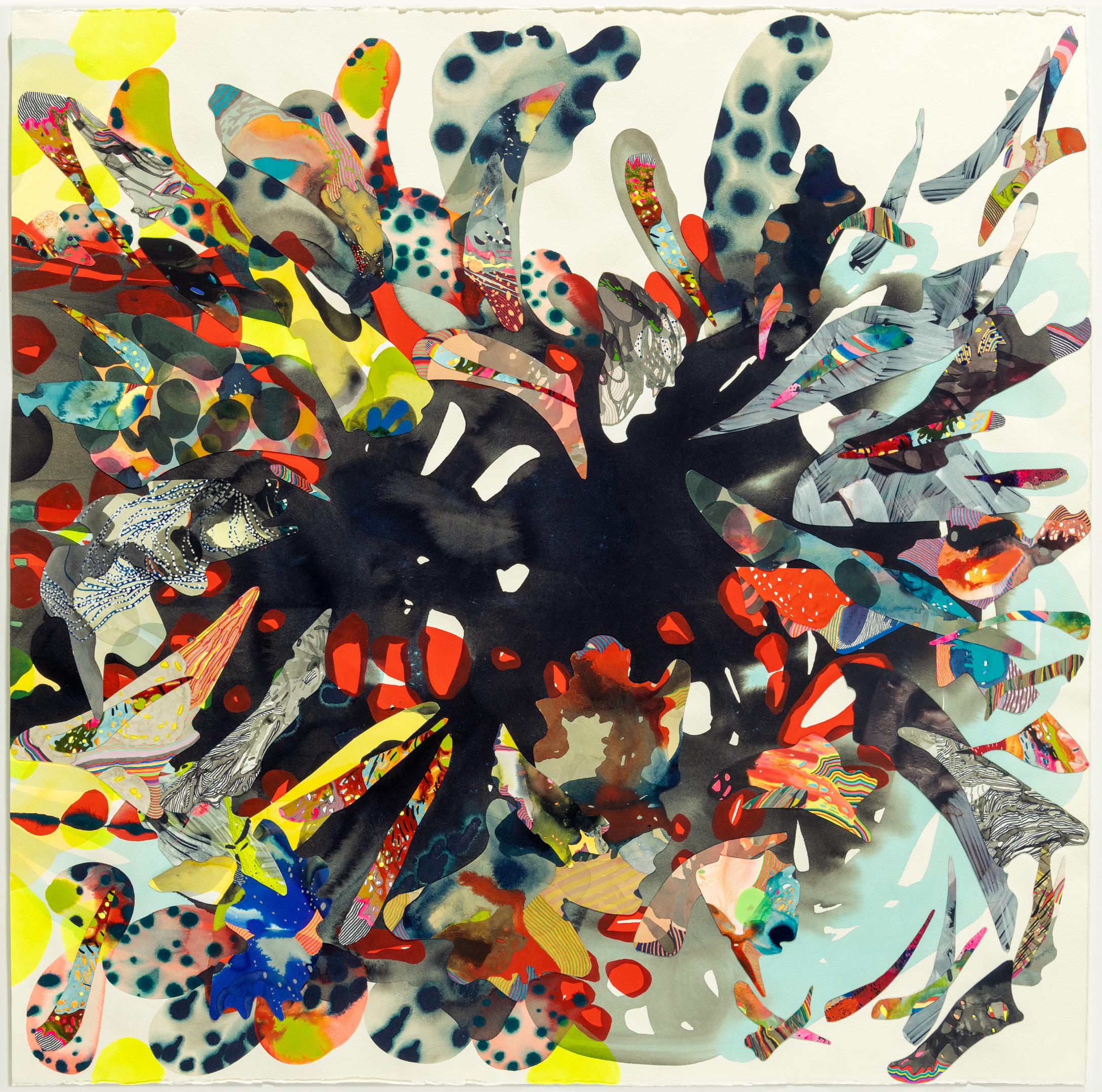
Path: Words Resting in Guts 2020 Acrylic, inks, collage on paper 44” x 44”
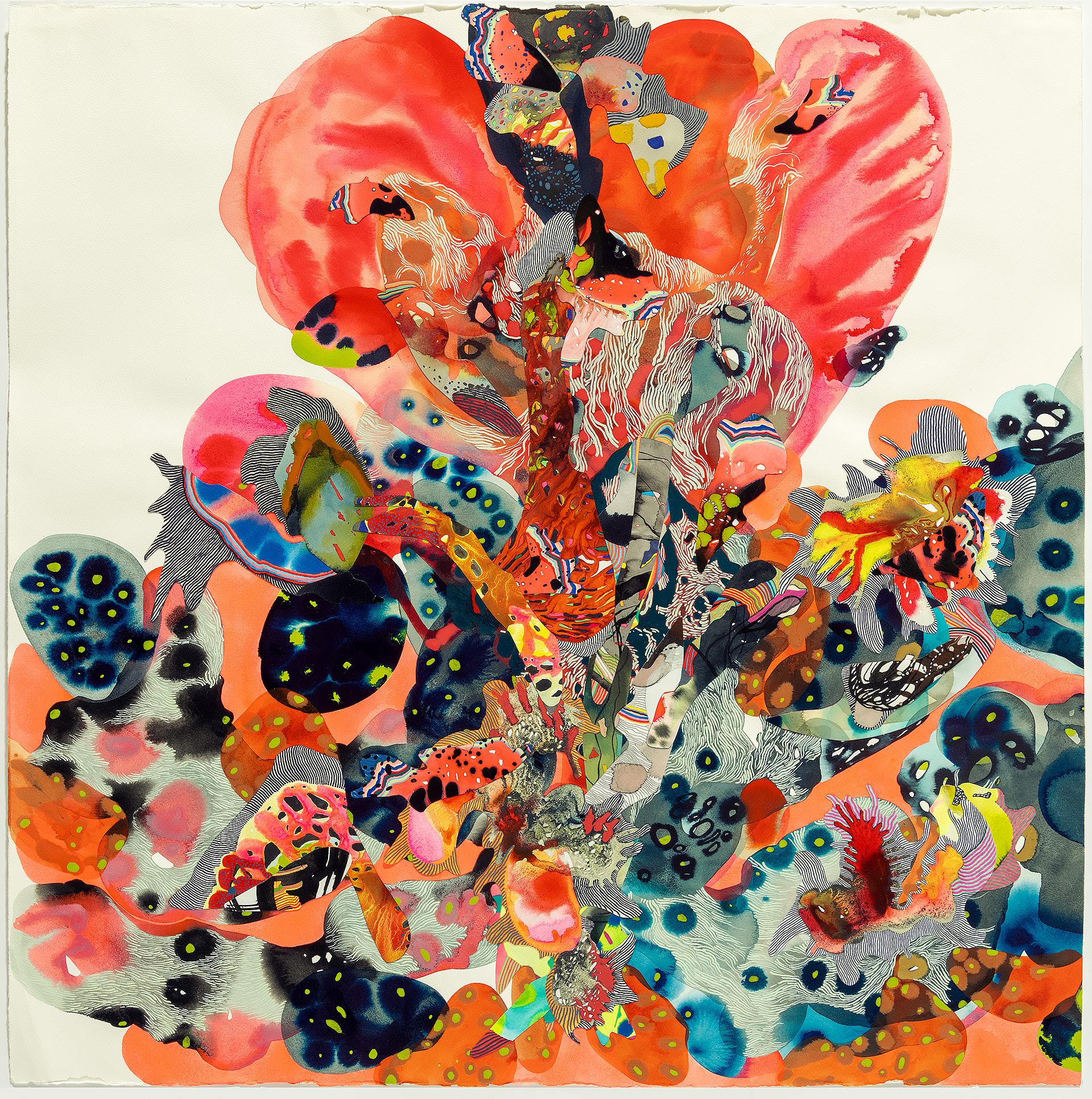
Path: Well Worth Waiting 2020 Acrylic, inks, collage on paper 44” x 44”

Path: Sea Beds Dried 2020 Acrylic, inks, collage on paper 44” x 44”

Path: Black, Wet, Stones 2020 Acrylic, inks, collage on paper 44” x 44”

Path: Honeyed Beach 2020 Acrylic, inks, collage on paper 44” x 44”
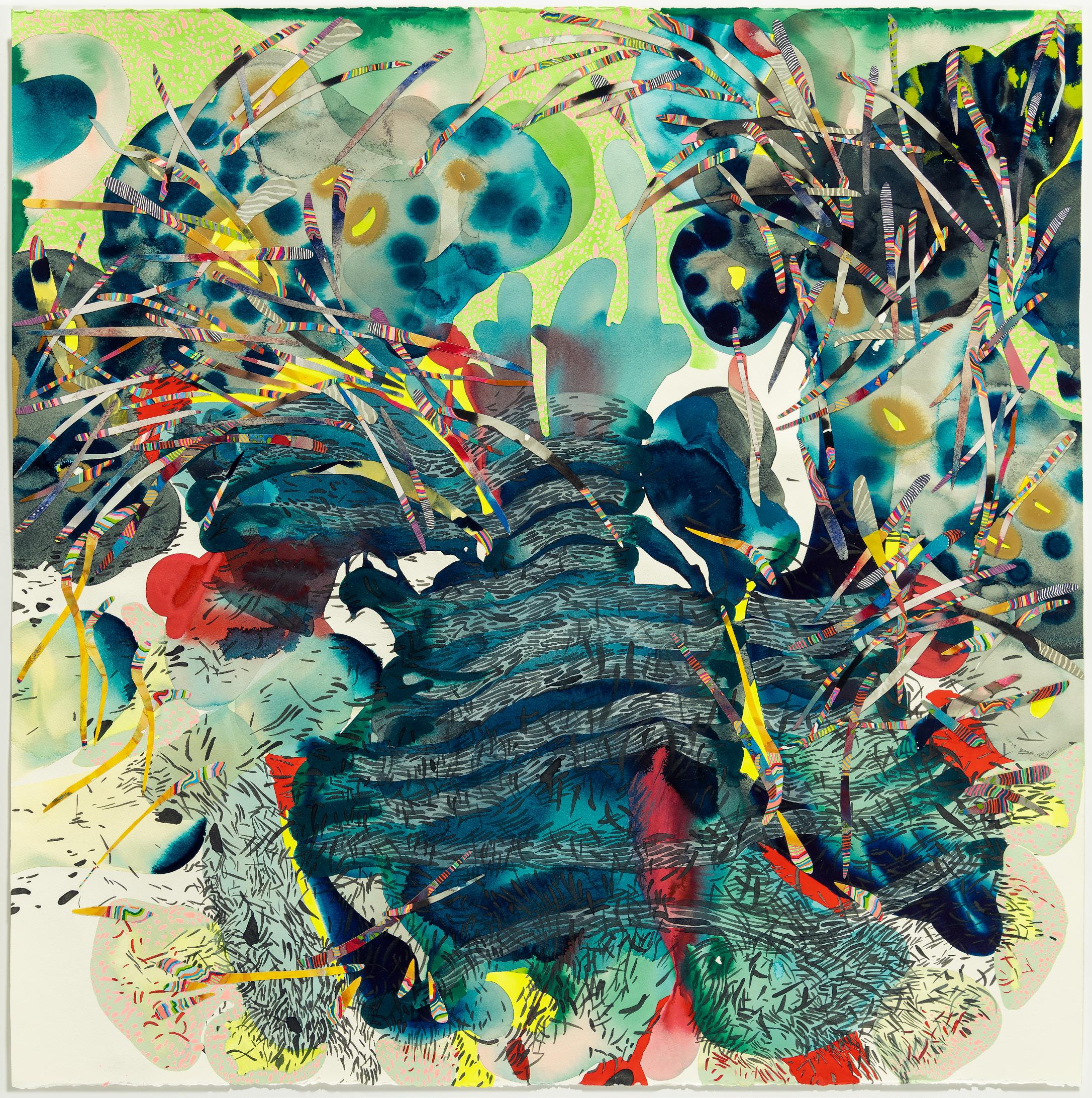
Path: Fist Plunged in Firefly 2020 Acrylic, inks, collage on paper 44” x 44”
For Anne Austin Pearce: By Yxta Maya Murray
She walks to her studio. She’ll paint there. She’ll write.
She takes the long path.
There is no other path.
It’s an old road. Many women have traveled it.
Still, she’s alone as she makes her way.
It’s an ancient passage. Once there was an ocean here. Whales swam in it.
Lobsters crawled on this ground. Lichen, sea-coral, greenweed, kelp, and red algae floated above.
Now there are woods and birds. She sifts through the shadows
as she moves forward. She sees the redbud and the tangerine flower.
The world collects in a violent way upon the lime leaf of the sapling.
The orchid is the color of veins and pale hands grasping.
No one will protect her in this place.
She loves it so much she wishes she didn’t have to die.
It’s hard to make art.
It’s impossible to make art.
In dread she walks the path to the studio where she must wrench her thoughts
onto the paper. The tangerine and ink-spill of the flower are untranslatable
until an accident occurs, or many hours of furious and insane labor have passed.
No one wants you, and no one cares, she hears someone murmuring in the bushes.
But when she looks under the daisy, she sees herself crouching there, talking garbage.
On this path there reigns a refreshing and total uncaring.
She can do what she wants.
She can do what she wants with the indigo spider that becomes something else.
The dark creature shifts into a blue-spotted palm, which is threaded by pink crystals and
harnessed by ebony thumbprints and a flexing of grisaille.
She decides where to place the yellow.
She knows that yellow is better than buttercup or canary, here.
A breeze blows through the world.
The making lifts her up so that she joins the flourishing of the trees.
On the path, sadness turns green, like tree moss.
When she gets to the studio it could all turn into ash,
which will go into the painting or the poem.
It all goes into the painting or the poem:
She decants youth, love, sickness, death, work, disappointment, and questions about how
to live upon the worktable.
At the age of fifty years old, a woman artist becomes a monster.
She rises from the salt with the timeless fish who once ruled this forest.
It’s taken a full life to finally make this mark with the charcoal.
A whole life to make the mark.
She opens the door.
O’Keefe, Morrison, Gentileschi, Woolf, Morisot.
Anguissola, Rosa Rolanda, Mickalene Thomas, Lee Krasner.
Hurston, Sappho, de Beauvoir, Austen, Chopin, Butler, Dickinson.
Mitchell, Delaunay, Carrington, Baroness von Freytag-Loringhoven.
Art made you happy, right?
The gods are silent in this garden as she treads the fossils and plucks a piece
of bark, noticing the pattern on it.
She introduces the data into the brightness of her mind
and does not know what will become of it.
Yxta Maya Murray Bio
Yxta Maya Murray is a novelist, art critic, playwright, and law professor. The author of nine books, her most recent are the forthcoming story collection, The World Doesn’t Work That Way, but It Could (University of Nevada Press, 2020), and the novel, Art Is Everything (TriQuarterly Press, 2021). She has won a Whiting Award, an Art Writer’s Grant, and has been named a fellow at the Huntington Library for her work on radionuclide contamination in Simi Valley, California.

2004 Baltimore Ave. Kansas City, MO 64108 | 816.221.2626 | sherryleedy.com

